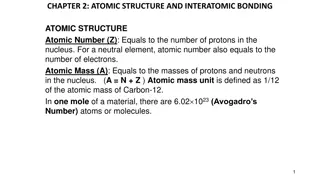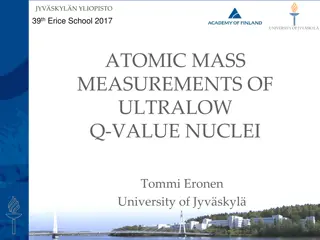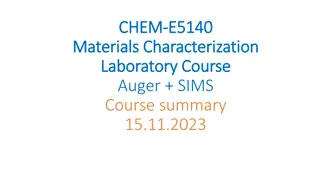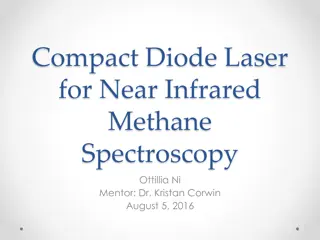NMR Spectroscopy for Structure Identification
NMR spectroscopy is a powerful tool in determining the structure of organic compounds. This summary outlines the process of using 1H NMR spectroscopy to identify an unknown compound, detailing steps such as determining different proton types, analyzing integration data, and interpreting splitting pa
5 views • 40 slides
Atomic Configurations and Term Symbols
The energy of atomic configurations is determined by electrostatic attraction between electrons and the nucleus, electron-electron repulsion, spin-orbit coupling, and spin-spin interactions. Term symbols in electronic spectroscopy specify atomic states using quantum numbers. Hund's rule and the Paul
13 views • 12 slides
Slitless Stellar Spectroscopy with the SA100 Grating Procedures
Explore the world of slitless stellar spectroscopy with the SA100 grating as detailed by Anthony Harding in the ongoing creation of the Harding Spectra Library. Learn about the equipment used, the process of determining instrument response, capture procedures, and stacking techniques for obtaining s
4 views • 30 slides
NMR Spectroscopy of Paramagnetic Molecules
NMR spectroscopy of paramagnetic molecules is influenced by the presence of unpaired electrons, leading to broadened spectra and complex coupling mechanisms. Quadrupolar nuclei, with spins greater than 1/2, play a significant role in the relaxation and splitting of NMR signals. The interaction betwe
6 views • 19 slides
Raman Spectroscopy: Principles and Applications
Raman spectroscopy is a technique used for chemical analysis by exciting molecular vibrations with light. This inelastic scattering of light allows researchers to gather valuable information about samples. The method relies on the Raman effect, discovered by C.V. Raman, which involves the emission o
2 views • 14 slides
UV/Visible Spectroscopy and Electromagnetic Radiation
Spectroscopy is the study of the interaction of matter with light, specifically UV and visible radiation. Electromagnetic radiation, consisting of photons, transmits energy through space as waves with oscillating electric and magnetic fields. The relationship between wavelength and frequency is key,
2 views • 50 slides
The Basics of 13C NMR Spectroscopy
Nuclear Magnetic Resonance (NMR) Spectroscopy is a powerful analytical tool used in chemistry to study the structure of molecules. This summary focuses on the application of 13C NMR spectroscopy, which provides valuable information about carbon atoms in a compound. The low natural abundance of carbo
1 views • 36 slides
Basic Concepts of Hyperspectral Imaging and Spectroscopy
Exploring the fundamental principles of hyperspectral imaging and spectroscopy, this content covers topics such as interference, diffraction, spectrometer workings using diffraction gratings, and wave properties. Lectures by Adjunct Professor Fred Sigernes delve into topics like basic spectroscopy,
0 views • 21 slides
Structural Elucidation of Chemical Compounds Using Spectroscopy Techniques
This presentation discusses the various types of spectroscopy techniques such as UV-Visible, IR, Raman, NMR, and others used for elucidating the structure of chemical compounds. It covers the identification of molecule shapes like AB2, AB3, and AB4, with a focus on linear and non-linear structures.
9 views • 18 slides
NMR Spectroscopy and Chemical Shifts
Nuclear Magnetic Resonance (NMR) spectroscopy is a powerful technique for analyzing molecular structures based on the chemical shifts of protons. In an NMR spectrum, peaks correspond to different protons in a compound, with their positions, intensities, and spin-spin splitting providing valuable inf
2 views • 19 slides
Atomic Spectroscopy and Atomization in Analytical Chemistry
Explore the principles of atomic spectroscopy through examples and theories, focusing on topics such as the Boltzmann distribution problem and atomization processes using flames. Learn about the challenges and complications in atomization, including issues with nebulization efficiency and poor volat
7 views • 20 slides
Atomic Structure and Interatomic Bonding
Atomic structure is defined by the atomic number (Z) and atomic mass (A). Quantum mechanics governs atomic and subatomic particles, introducing discrete energy levels. The Bohr atomic model describes electrons orbiting the nucleus in defined orbitals. Quantum numbers characterize electron properties
2 views • 15 slides
Techniques for Hadron Spectroscopy Studies at LHCb
Hadron spectroscopy studies at LHCb focus on searching for new hadrons, measuring their properties like lineshape, lifetime, and decay modes. The LHCb detector is optimized for collecting, reconstructing, and identifying signals to improve knowledge about hadron spectroscopy. Development of data ana
1 views • 30 slides
Physics Beyond the Standard Model through Atomic Spectroscopy
Unlocking the mysteries of physics beyond the Standard Model using atomic spectroscopy techniques. Delving into the shortcomings of the Standard Model and the quest for new physics through precision measurements of atomic forces and isotope shifts in heavy atoms. Highlighting the importance of the p
0 views • 47 slides
Atomic Mass Measurements of Ultralow Q-Value Nuclei at University of Jyvaskyla
Explore the cutting-edge research on atomic mass measurements of ultralow Q-value nuclei conducted at the University of Jyvaskyla. This research delves into various techniques such as Penning trap atomic mass spectroscopy and PI-ICR to study Q-values for reactions and neutrino studies. The investiga
0 views • 29 slides
Advances in Baryon Spectroscopy and Hadronic Matter Studies
Discussions at the meeting focused on interpreting HADES results for e+e- and meson production in hadronic reactions, with studies involving proton, pion, light, and heavy ion beams. The role of time-like electromagnetic transitions, baryon spectroscopy, and connecting hadronic matter studies were e
5 views • 12 slides
Auger Spectroscopy: Techniques and Applications in Materials Characterization
Auger spectroscopy, named after Pierre Auger, is a powerful technique for analyzing the surface composition of materials at the atomic level. This method involves the emission of Auger electrons and characteristic x-rays upon interaction with an electron beam. It offers high surface sensitivity, ena
0 views • 29 slides
Overview of Auger Spectroscopy in Materials Characterization
Auger spectroscopy is a powerful technique used for materials characterization, involving the emission of Auger electrons to analyze the elemental composition of a sample. Named after Pierre Auger, this method provides valuable information about the surface properties of materials. The technique is
0 views • 24 slides
Atomic Structure in Introductory Chemistry
Explore the basics of atomic structure in Introductory Chemistry, covering topics such as representing elements with atomic symbols, isotopes, and atomic bookkeeping. Learn through visual aids and examples to enhance your understanding of elements, isotopes, and atomic properties.
5 views • 21 slides
The Importance of Atomic Clocks in Modern Technology
Explore the significance of precise timekeeping provided by atomic clocks, the fundamentals of atomic clocks, the advancements in single-atom optical clocks by experts like D. J. Wineland from NIST Boulder, the role of atomic energy state superpositions, and the practical operation of atomic clocks.
3 views • 33 slides
Insights into Theoretical Approaches in NMR Spectroscopy
Theoretical approaches in NMR spectroscopy encompass diverse methods, each with varying degrees of approximation but yielding correct results within their validity. Techniques such as transition probabilities using the time-dependent perturbation theory, Zeeman interaction for energy level transitio
0 views • 32 slides
Atomic Absorption Spectroscopy in Analytical Chemistry
Atomic absorption spectroscopy (AAS) is a valuable technique for determining metal concentrations in samples. This method involves the absorption of light to measure gas-phase atoms, requiring steps like desolvation, vaporization, and volatilization to convert samples into atomic gas. The process ut
2 views • 18 slides
Practical Advances in Pharmaceutical Analysis Using Spectroscopy Techniques
This comprehensive guide covers various spectroscopy techniques, including UV-Vis and IR spectroscopy, as well as electrochemical analysis and flame photometry, for pharmaceutical analysis. It delves into the fundamentals of molecular spectroscopy, discussing electromagnetic radiation, quantum energ
2 views • 19 slides
Lecture 7b
Nuclear Magnetic Resonance (NMR) Spectroscopy is a powerful technique used to analyze atomic structures in molecules. This technique, developed by Felix Bloch and Edward Purcell, has revolutionized the field of chemistry. Understanding the physical background of NMR spectroscopy is crucial for inter
9 views • 19 slides
MR SPECTROSCOPY
MR Spectroscopy is a technique for analyzing in vivo chemical environments to study neurophysiology and neurochemistry. This quantitative noninvasive assay allows for the identification of various metabolites such as NAA, choline, creatine, lipids, and lactates. Data collected are analyzed in the ti
0 views • 22 slides
Atomic Absorption Spectroscopy and Inductively Coupled Plasma
Principles and techniques behind Atomic Absorption Spectroscopy (AAS) and Inductively Coupled Plasma (ICP) analysis. Learn about transducers, light sources, sample cells, drawbacks, and advancements in spectroscopic methods.
0 views • 10 slides
Compact Diode Laser for Near Infrared Methane Spectroscopy
Explore the development of a compact diode laser for near infrared methane spectroscopy, including motivation, challenges, methane absorption spectroscopy, and assembling the laser components. Learn about the interior of the diode laser and the powering mechanisms involved in this innovative technol
0 views • 11 slides
Applications of Mossbauer Spectroscopy in Chemistry Studies
Explore the principles and applications of Mossbauer spectroscopy in chemistry through the work of Dr. A. Simi, Assistant Professor at St. Joseph's College, Trichy. Learn about nuclear gamma resonance spectroscopy, recoil effects, and the impact of momentum conservation in emission processes. Discov
1 views • 81 slides
Atomic Spectroscopy and Mass Spectrometry Lecture Overview
Learn about atomic spectroscopy, including emission spectrometers and interference in measurements, as well as an introduction to mass spectrometry in this comprehensive lecture. Explore the principles, instruments, and applications discussed in the lecture slides.
1 views • 20 slides
Photonics-Based Terahertz Spectroscopy System for Pharmaceutical Tablet Manufacturing
Addressing challenges in pharmaceutical tablet manufacturing through terahertz spectroscopy. Learn about the photonics-based wideband spectroscopy system developed by Prof. Guillermo Carpintero for monitoring and optimizing the manufacturing process. Find out how this innovative technology helps in
0 views • 4 slides
Raman Spectroscopy Basics and Applications
Explore the fundamentals of Raman spectroscopy, a valuable analytical technique complementary to IR spectroscopy. Learn about the principles, types of Raman scattering, active Raman vibrations, and how Raman spectra differ from IR spectra. Discover the unique capabilities and applications of Raman s
4 views • 19 slides
NMR Spectroscopy: 13C-NMR Introduction and Chemical Shift Analysis
Explore the principles of 13C-NMR spectroscopy, including the unique features of carbon-13 nuclei, proton decoupling, chemical shift ranges, functional group identifications, and the effects of environmental factors on chemical shifts. Enhance your understanding of NMR spectroscopy for chemical anal
5 views • 21 slides
Core-Level Spectroscopy of Solids: Energy Ranges and Measurements
Explore the energy ranges and spectroscopic measurements in core-level spectroscopy of solids, covering topics such as X-ray Absorption Spectroscopy (XAS) and Photoelectron Spectroscopy (XPS). Learn how XPS measures the energy of occupied orbitals and its implications for oxidation state determinati
1 views • 11 slides
Challenge: Atomic Structure of Copper 65 and Bohr Model Overview
Explore the atomic structure of Copper 65 by determining the number of protons, neutrons, and electrons, as well as the atomic number and mass number. Additionally, review the Bohr model and its application in understanding atomic structure and electron configurations. Get ready to dive into the wor
3 views • 8 slides
Proton Nuclear Magnetic Resonance Spectroscopy Overview
Dive into the world of Proton Nuclear Magnetic Resonance (PMR or 1H NMR) Spectroscopy with insights on its definition, applications, historical significance, and available techniques for structure elucidation. Discover the basic components, electromagnetic radiation, and wavelength concepts associat
15 views • 16 slides
Advanced Spectroscopy Techniques for Detailed Analysis
Explore a visual journey through various advanced spectroscopy techniques used for in-depth analysis in scientific research and applications. From UV-Vis spectroscopy to Raman spectroscopy, these images provide a glimpse into the world of spectroscopic analysis.
1 views • 37 slides
Spectroscopic Instrumentation and Atomic Spectroscopy Overview
Explore the world of spectroscopic instrumentation in chemistry, covering topics such as light detectors, spectrometers, and atomic spectroscopy for elemental composition analysis. Learn about different types of detectors, instrument performance concerns, and systems for analyzing solid and liquid s
0 views • 16 slides
Laser Spectroscopy at N = 20 and N = 40: Insights and Findings
Explore the fascinating world of laser spectroscopy at N = 20 and N = 40 as Jordan Reilly delves into the Island of Inversion, CRIS Technique, and more. Discover the implications of neutron-rich Al and the PI-LIST technique, shedding light on islands of inversion and the unique characteristics obser
2 views • 20 slides
Understanding Isotopes and Average Atomic Mass in Chemistry Studies
Explore the concepts of isotopes, atomic mass, and atomic structure in chemistry through an insightful discussion on Dalton's atomic theory, isotopes of hydrogen, and calculations of atomic mass using weighted averages. Learn about the unit for average atomic mass (AMU), the definition of atomic mas
0 views • 11 slides
Advanced Spectroscopy Techniques
Explore advanced spectroscopy techniques such as third-order spectroscopy, transient grating, pump-probe methods, coherence, and more in this detailed presentation by Andrei Tokmakoff from MIT Department of Chemistry. Learn about nonlinear spectroscopy applications and principles in the field of che
1 views • 9 slides







































